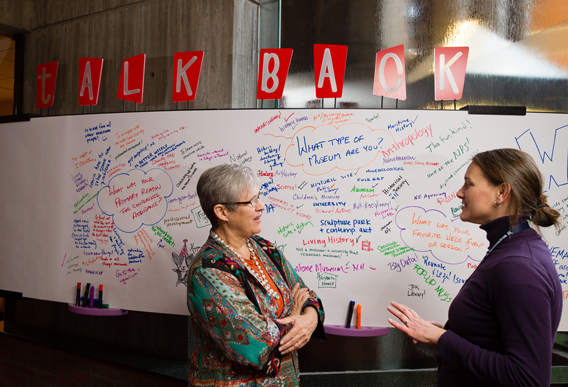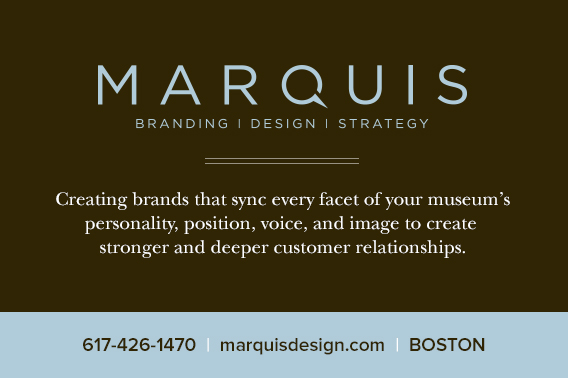
1,200 Attendees, Thousands of Insights
By Emily Robertson, 2014/15 NEMA Fellow
Emily Robertson is the 2014/15 NEMA Fellow. As part of the fellowship Emily is writing a series of articles for the NEMA community. Here are her reflections on the most recent conference.

The 96th annual New England Museum Association Conference was one for the record books. Not only did it return to Boston and Cambridge, MA, for the first time in 27 years, the Conference also had record-breaking attendance. More than 1,200 people from all over the museum community created the largest regional gathering of museum professionals in US history! And what a gathering it was. Attendees hailed from all six New England states and from as far away as Virginia, California, and Washington State.
The attendance numbers were phenomenal, but what struck me the most were the thousands of insights developed and shared between colleagues during the three-day conference. Perhaps that number is unmeasurable but the opportunities for these connections can be counted. A quick glance at the event’s offerings reveals these numerous opportunities:
The 2014 Conference by the Numbers
- 67 concurrent sessions on topics from all disciplines
- One thought-provoking keynote panel examining the conference theme
- 13 off-site sessions, including tours of Mt. Auburn Cemetery and the Harvard Museums of Science and Culture, and a boating excursion on the Fort Point Channel led by the Hull Lifesaving Museum! (I didn’t attend that one but I heard it was really fun!)
- Eight Professional Affinity Group lunches featuring updates on current topics in the field
- Four fabulous evening events at sites in Boston and Cambridge
- More meetings of old and new friends than we can count!
I attended my first NEMA conference in 2004, and I have been to every conference since. I recently stepped outside the field for two years to earn my MBA, but I took time out of my studies to make it to the conference because I knew that it was the best place to maintain my museum ties and keep up with what is happening in our field. I have been fortunate to attend many regional and national conferences during my career, and the NEMA conference always stands out as one of the best. This year was no different. There was something for everyone at the 2014 NEMA conference. We joined together in spirited discussions with speakers from around New England and beyond, on topics as varied as legal issues, museum mergers, spirituality in museums, writing successful grant proposals, docent tours via Skype, and effective governance. How lucky are we to have such dedicated professionals right here in New England? We do not have to go very far to take interesting behind-the-scenes tours, hear provocative presentations, and interact with people from all of the field’s disciplines.
For more than a decade the NEMA conference has impacted me personally because each year I go home with new insights that I can use right away in my career planning and my everyday work. I often hear this sentiment echoed from other attendees as well. The 2014 conference delivered on my expectation of timely and relevant knowledge and connections with colleagues. I would like to share just a few insights gained from my experience at the 2014 NEMA conference:
The 2014 Conference Keynote Panel:
Moderator: Jared Bowen of WGBH-Boston.
Panelists: Malcolm Rogers of the Museum of Fine Arts, Boston; Carole Charnow of Boston Children’s Museum; Carl Nold of Historic New England; Dr. Lisa Wong of Harvard Medical School and the Massachusetts Cultural Council; and Dr. Joel Katz of Brigham and Women’s Hospital.
The theme of the conference was “Picture of Health: Museums, Wellness, and Healthy Communities.” The keynote shaped the conference theme and provided additional context for the many concurrent sessions that concentrated on health and wellness. The panelists shared ways that museums have been meeting the health and wellness needs of their communities, and they examined the challenges that lie ahead. I appreciated hearing from both museum and medical professionals on the panel, and their participation in the keynote demonstrated to me that museums have a real place in contributing positively to the health and wellness of our communities. If you missed the keynote, you can view a video recording of the panel here.
New this Year: The Pop-Up Museum
Hosts: Jan Crocker, Exhibits Manager, Heritage Museums and Gardens, MA; Lynn Baum, Principal, Turtle Peak Consulting, MA; and Brad Larson, Principal, Bard Larson Media, MA.
New this year to the conference was a very special evening event: NEMA’s first-ever Pop-Up Museum! A Pop-Up Museum is just as it sounds: it is a temporary exhibit that “pops up” for just a few hours in a temporary space. NEMA’s Pop-Up Museum took place on the Tuesday evening before the conference began, providing a casual venue to bring conference attendees together around a fun, informal topic. Our hosts Jan, Lynn, and Brad chose an interesting theme for the museum: “What do you create or do when you’re not working?” As exhibitors gathered before the museum opened, Lynn led them in an exhibit label writing exercise. About 20 exhibitors showcased many talents and hobbies, from artwork to special collections to favorite activities. I exhibited my voice-over work through a small, portable audio system. It was the tiniest exhibit I have ever produced!
Demonstration Station: “How to Catch an Interview and Snare the Job with the Right Resume”
Presenter: Angela Cheng-Cimini, Director of Human Resources, Old Sturbridge Village, MA.
The conference featured seven Demonstration Stations, which are 30-minute sessions offering hands-on tips on topics such as mobile apps, graphic design, and textile storage. At this Demonstration Station I loved the useful discussion on effective resume-writing strategies. Angela described the advantages of writing a customized resume and cover letter for each job application, and focusing your message on only the relevant content that showcases how your skills match a job’s needs. All of us can use this advice, even if we are not seeking a new job. Whether we are writing a press release, an exhibit label, or a grant proposal, we all can improve our ability to focus our message, write less, and say more.
Session: THINK TANK: How can we diversify the museum field?
Facilitators: Kristin Gallas, Director of Interpretation Projects, The Tracing Center on Histories and Legacies of Slavery, MA; Pilar Garro, Castle Hill Engagement Manager, The Trustees of Reservations, MA (NEMA Board); Maria Cabrera, Supervisor, Community Relations, Museum of Science, Boston (NEMA Board); Wyona Lynch-McWhite, Executive Director, Fruitlands Museum, MA (NEMA Board); Purvi Patwari, Director of Human Resources, deCordova Museum and Sculpture Park, MA.
Also new this year were two THINK TANK sessions, one on diversity and one on social responsibility. The purpose of both THINK TANKS was to provide provocative and interactive conversations with the goal of identifying action steps for positive change in the field. Facilitators of the Diversity THINK TANK led us in a conversation on a variety of topics impacting diversity, including exhibit and program content and seeking more diversity in staff and volunteer recruitment. The facilitators posed questions such as “Why diversify?” and “How can NEMA diversify?” Later we broke into small roundtable groups led by a facilitator. In my roundtable group, we brainstormed ways museums can be more welcoming for visitors with disabilities. NEMA will be putting together all of the feedback received during both THINK TANK sessions to inform a long-term effort beyond the conference sessions.
Session: Get Organized!
Presenter: Marilyn Weiss Cruickshank, Productivity Consultant, Creative Simplicity, MA.
I have a confession: I was drawn to this session because I have a messy office, and I wanted to learn some tips about how to improve the state of my office. But I ended up coming away with an awareness of how clearing clutter can positively impact how organizations function. Marilyn led our group in a discussion that revealed the many ways that people can organize items in a space, and how organization can be made easier by identifying how you want your space to work and by tackling small projects first. While I am still confronting the endless paper in my office, I am proud to say that I have put much of Marilyn’s advice to work in my own space, resulting in better functioning work areas.
These were just a few of the insights I gained at the 2014 NEMA conference. I am sure that among the 1,200 attendees, there were thousands more new ways to think about museums and our work.
I hope you’ll join me November 4-6 in Portland, Maine for the 2015 NEMA conference!
Emily can be reached at erobertson3@babson.edu.
